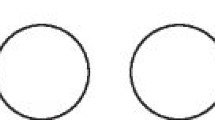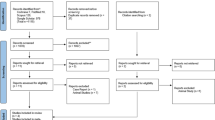Abstract
Data sources
Pubmed, Embase, Google scholar beta and the Cochrane Databases.
Study selection
Randomised controlled trials (RCTs) and controlled clinical trials (CCTs) reporting on results or treatment parameters related to accelerated orthodontic tooth movement were considered.
Data extraction and synthesis
Data abstraction and quality assessment using the Cochrane risk of bias tool were carried out independently by two reviewers. A meta-analysis and narrative synthesis was presented.
Results
Eighteen studies (342 patients ) were included. Eight involved low intensity laser, seven corticotomy, and interseptal bone reduction, pulsed electromagnetic fields and photobiomodulation were each investigated by a single trial. Twelve RCTs and six CCTs were included. Two RCTs were considered to be at low risk of bias, five at unclear risk and five at high risk of bias. Three CCTS were at high risk of bias and three at unclear risk. Two studies on corticotomy and two on low intensity laser were combined in a random effects model. Higher canine retraction rate was evident with corticotomy during the first month of therapy (WMD=0.73; 95% CI: 0.28, 1.19, p<0.01) and with low intensity laser (WMD=0.42mm/month; 95% CI: 0.26, 0.57, p<0.001) in a period longer than three months. The quality of evidence supporting the interventions is moderate for laser therapy and low for corticotomy intervention.
Conclusions
There is some evidence that low intensity laser therapy and corticotomy are effective, whereas the evidence is weak for interseptal bone reduction and very weak for photobiomodulation and pulsed electromagnetic fields. Overall, the results should be interpreted with caution given the small number of studies, allied to limited quality and heterogeneity of the included studies. Further research is required in this field with additional attention to application protocols, adverse effects and cost-benefit analysis.
Similar content being viewed by others
Commentary
The duration of a course of orthodontics is contingent on a variety of factors including the dictates of a presenting malocclusion, operator factors, treatment mechanics and biological response to incident force. Orthodontic tooth movement involves complex interplay between mechanical forces and an ensuing biological response involving chemical interactions between osteoblasts and osteoclasts, cellular turnover and bone remodelling. In recent years efforts to modulate this biological response using both surgical and non-surgical adjuncts have gained momentum.
This review aimed to systematically review the effectiveness of both surgical and non-surgical approaches to accelerating orthodontic tooth movement. The search strategy is detailed and the methodology is clear and appropriate. The study also addresses an area relevant to practising orthodontists and our patients, and updates a previous review based on a search in 2011.1 The main outcome measure was the rate of tooth movement. The impact of adjunctive procedures on quality of life and the occurrence of adverse events were also assessed.
Both randomised and non-randomised studies were included in the review with 18 studies contributing to a qualitative synthesis and six included in meta-analyses. Of the 18 studies identified, eight related to low intensity laser therapy and seven focused on the effectiveness of surgically assisted treatment. The authors arbitrarily scored the risk of bias as unclear for random sequence generation and allocation concealment in the non-randomised studies. Consequently, one non-randomised as well as five randomised studies were included in the meta-analyses.
In terms of adjunctive surgical procedures, an increase in the rate of tooth movement of the order of 0.73mm over a period of one month was identified on the basis of two trials comprising just 23 participants.
The overall quality of evidence was adjudged to be low using the GRADE tool. It is likely, therefore, that further research may alter the magnitude and direction of the difference identified in the present review. Moreover, the impact of the surgical procedure is likely to wane over time with repeated surgery likely required to sustain the benefits of faster treatment. Obviously, this potential requirement for additional surgery may pose additional risk.
With respect to low intensity laser therapy, similar results were observed with a marginal increase in the rate of canine retraction (0.42mm/month) over a period of 3-4.5 months. Again this finding was based on just two studies, with a significant degree of statistical heterogeneity.
Overall, it was disappointing to note that minimal data were available concerning the bearing of adjunctive procedures on quality of life and adverse events. Assessment of these outcome measures may be particularly pertinent in the case of surgical adjuncts, as these procedures constitute an additional elective procedure during a course of non-surgical orthodontics; it would therefore be intuitive to expect an impact on patient experiences and an inflated risk of morbidity.
In conclusion, the authors caution that the results are based on a limited number of heterogeneous studies. Consequently, a need for larger, high quality randomised studies exists. It is also important that future studies consider treatment in its entirety to provide a holistic assessment of the potential risk and benefit of adjunctive surgical procedures, in particular.
Practice point
-
There is low quality evidence suggesting an increase in the rate of tooth movement with adjunctive surgical procedures and low intensity laser therapy based on short-term studies.
-
Further studies assessing the potential value of both surgical and non-surgical adjuncts with consideration of patient experiences and adverse events are required.
References
Long H, Pyakurel U, Wang Y, Liao L, Zhou Y, Lai W . Interventions for accelerating orthodontic tooth movement: a systematic review. Angle Orthod 2013; 83: 164–171.
Author information
Authors and Affiliations
Additional information
Address for correspondence: N. Gkantidis Department of Orthodontics and Dentofacial Orthopedics, University of Bern, Freiburgstrasse 7, CH-3010 Bern, Switzerland. E-mail address: nikosgant@yahoo.gr
Gkantidis N, Mistakidis I, Kouskoura T, Pandis N. Effectiveness of non-conventional methods for accelerated orthodontic tooth movement: a systematic review and meta-analysis. J Dent 2014; 42: 1300–1319. doi:10.1016/j.jdent.2014.07.013. Epub 2014 Jul 27. PubMed PMID: 25072362.
Rights and permissions
About this article
Cite this article
Fleming, P. Accelerating orthodontic tooth movement using surgical and non-surgical approaches. Evid Based Dent 15, 114–115 (2014). https://doi.org/10.1038/sj.ebd.6401063
Published:
Issue Date:
DOI: https://doi.org/10.1038/sj.ebd.6401063



